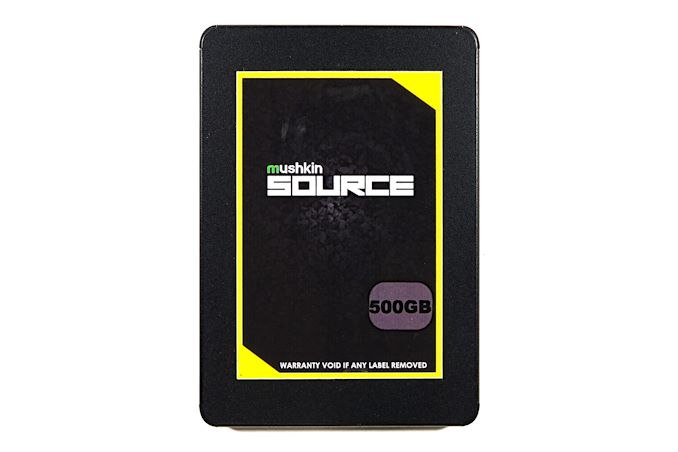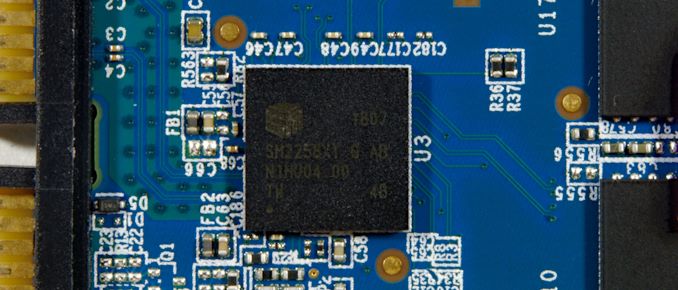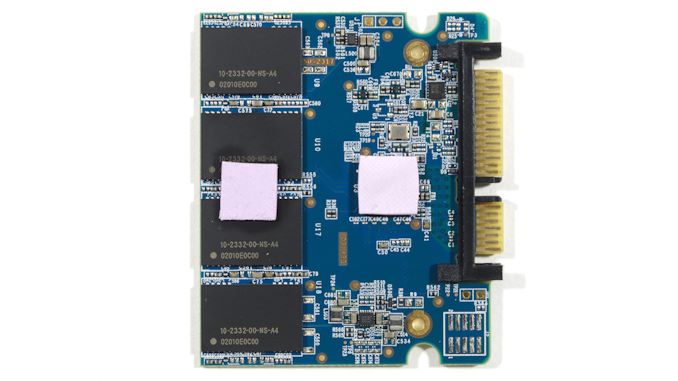The Mushkin Source 500GB SATA SSD Review: A Value Proposition For An Everyday PC
by Billy Tallis on November 21, 2018 10:00 AM EST
QLC SATA SSDs haven't quite hit the consumer market just yet, so the most affordable entry-level SSDs are still DRAMless designs with TLC NAND. The Mushkin Source is a current-generation example that provides only modest improvements over older DRAMless SSDs, but is adequate for most home systems.
Source: The Secret Sauce is $0.13/GB
The Mushkin Source is an entry-level SSD designed to offer the absolute lowest cost possible from current-generation components. The 500GB drive we're testing today is currently for sale at $65, putting the price per GB at a very low $0.13.
Specifications for our drive look pretty standard for a drive in this price range: peak sequential read speeds of 560 MB/s, writes at 520 MB/s, and 75k/81k IOPs respectively. Mushkin rates the drive at 2 W active and 80 mW idle, and with a three-year warranty that is typical for entry-level SSDs. The write endurance ratings are pretty low - for this 500GB drive that is 200TB total writes, which equates to a paltry 0.22 drive writes per day over those three years, equivalent to about 0.13 DWPD over five years (our usual metric).
| Mushkin Source SSD Specifications | ||||||
| AnandTech | 120 GB | 250 GB | 500 GB (Tested) |
1 TB | ||
| Form Factor | 2.5" SATA or M.2 2280 SATA | |||||
| Controller | Silicon Motion SM2258XT | |||||
| NAND Flash | Micron 64L 3D TLC | |||||
| Sequential Read | 510 MB/s | 560 MB/s | 560 MB/s | 560 MB/s | ||
| Sequential Write | 440 MB/s | 515 MB/s | 520 MB/s | 520 MB/s | ||
| Random Read | 29k IOPS | 54k IOPS | 75k IOPS | 78k IOPS | ||
| Random Write | 79k IOPS | 81k IOPS | 81k IOPS | 81k IOPS | ||
| Power | Active | 2 W | ||||
| Idle | 80 mW | |||||
| Warranty | 3 years | |||||
| Write Endurance | 50 TB 0.22 DWPD |
100 TB 0.22 DWPD |
200 TB 0.22 DWPD |
400 TB 0.22 DWPD |
||
| Current Retail | $27.99 (23¢ / GB) |
$41.99 (17¢ / GB) |
$64.99 (13¢ / GB) |
$135.99 (14¢ / GB) |
||
That endurance value is almost as low as what we're seeing from SSDs that use QLC NAND, and is likely due to a combination of the DRAMless controller making it harder to keep write amplification low, and Mushkin potentially using somewhat lower-grade flash in the Source. Nevertheless, the aim of this drive is primarily cost, and is aimed at a home user unlikely to do 100GB of writes per day every day.
How to Get Cheap before QLC Hits The Market
SATA SSDs with four-bit-per-cell QLC NAND flash memory are coming, but are not yet available in the consumer market and yield issues are preventing QLC from yet offering a meaningful discount relative to TLC NAND. That has led Mushkin to use a more familiar formula for the Source: 3D TLC NAND combined with a DRAMless SSD controller. Drives in this market segment always make sacrifices to reach the lowest price points, but they don't all make the same tradeoffs.
NAND flash memory prices have been in steep decline in recent months, and Mushkin has for the most part been able to keep pace with price drops for the Source. There have been occasions where more mainstream SATA drives with DRAM caches have gone on sale for lower prices than DRAMless drives, but the Mushkin Source has usually been quite close to being the cheapest SSD on the market from a reputable brand. Almost any SSD can garner some measure of success simply by being the cheapest. Being the cheapest *and* offering better than bottom-of-the-barrel specifications is harder to pull off.
The Mushkin Source uses Silicon Motion's SM2258XT controller, the DRAMless variant of the familiar SM2258. There is a newer SM2259 SATA controller but it doesn't offer any significant benefits for consumer SSDs, so the 2258XT can still be regarded as the current-generation solution from Silicon Motion. The Source uses Micron 64-layer 3D TLC NAND, which has proven to be much faster than their previous 32-layer 3D NAND and has been used in great products in all segments of the SSD market.
With only four NAND channels coming off the small SM2258XT controller and no external DRAM packages, the PCB inside the Mushkin Source is quite compact. Unusually, the SATA connector is not a discrete component attached to the edge of the circuit board but instead is formed from a combination of exposed contacts on the PCB itself and a plastic part to fill out the rest of the connector's shape. This may not be as durable as a discrete connector and certainly doesn't look as neat, but it works fine and probably saves a few cents. There's a token thermal pad between two of the NAND flash packages and the case, but is seems unlikely to have much effect on the drive's operation.
Mainstream SATA SSD product lines seldom offer a 120/128GB option these days due to the lower performance such small drives suffer from with only four NAND flash chips to work with. For entry-level products like the Mushkin Source, 120GB options are still relatively common even though they carry a significantly higher price per GB than 240GB and larger drives. As can be expected, the specifications for the smallest Mushkin Source reflect this lower performance, and the 250GB model improves on it but is still not up to full speed for things like random read throughput.
The primary competition for the Mushkin Source is other dirt-cheap SATA SSDs. Most of these are also DRAMless SSDs, usually based on Silicon Motion or Phison reference designs and sold by numerous brands. We have the Toshiba TR200 standing in for the Phison-based drives - availability of the TR200 has been inconsistent and pricing has often been far too high, but its performance is representative of cheaper products that use the same Phison S11 DRAMless controller with Toshiba 64L 3D TLC. The other DRAMless SSD in this review is the HP S700, which uses the same SM2258XT controller but older 32-layer Micron 3D TLC NAND.
It's also fair to compare the Source against mainstream SATA SSDs with DRAM caches, because the best deals in that market segment are usually within a few dollars of the going rate for DRAMless SSDs, and the more popular and thus higher-volume mainstream products occasionally end up undercutting DRAMless drives on price.
| AnandTech 2018 Consumer SSD Testbed | |
| CPU | Intel Xeon E3 1240 v5 |
| Motherboard | ASRock Fatal1ty E3V5 Performance Gaming/OC |
| Chipset | Intel C232 |
| Memory | 4x 8GB G.SKILL Ripjaws DDR4-2400 CL15 |
| Graphics | AMD Radeon HD 5450, 1920x1200@60Hz |
| Software | Windows 10 x64, version 1709 |
| Linux kernel version 4.14, fio version 3.6 | |
| Spectre/Meltdown microcode and OS patches current as of May 2018 | |
- Thanks to Intel for the Xeon E3 1240 v5 CPU
- Thanks to ASRock for the E3V5 Performance Gaming/OC
- Thanks to G.SKILL for the Ripjaws DDR4-2400 RAM
- Thanks to Corsair for the RM750 power supply, Carbide 200R case, and Hydro H60 CPU cooler
- Thanks to Quarch for the XLC Programmable Power Module and accessories
- Thanks to StarTech for providing a RK2236BKF 22U rack cabinet.

















30 Comments
View All Comments
Amandtec - Wednesday, November 21, 2018 - link
On PC Partpicker you can chose a chinese brand 500GB for about $42 vs about $72 for the Samnsung. So it is a little more than 10% difference.piroroadkill - Wednesday, November 28, 2018 - link
So $30 to not lose your data? Sounds like a good deal.piroroadkill - Wednesday, November 28, 2018 - link
Yeah, the SSD market is filled with wrong decisions.I just basically go for a TLC Samsung drive that fits the budget, and pretty much ignore everything else.
kmmatney - Wednesday, November 21, 2018 - link
Microcenter has their Inland 480GB SSD for $59.99. I have bought about 10 of the Inland SSDs so far, in various sizes (mostly the 240GB for $33). They have all worked great for normal everyday workloads, and most of these were installed as boot drives. The Microcenter SSDs are also DRAMless - maybe they don't bench as well, but they still have that SSD feel to them, and perform well doing normal tasks.fmcjw - Wednesday, November 21, 2018 - link
Well written article, thorough but not verbose, thank you Billy! Reminds me of Anand and Bruce...Recently bought a 480GB no name SSD that uses the same controller and NAND for only around $40 (singles day deal here in my home market in Taiwan). It has similar characteristics to the Source as you described (full disk SLC cache, etc.), but returned it because it makes a loud/hi-freq electrical noise when written to and read from. Forums here say that the 2258XT (or its ASMedia licensed copy) can overheat under heavy use and die before the NAND expires, so thermal design and general electrical design/component quality is critical. I'm not sure if you examined these design flaws or if you plan to add them to future routines? Granted it's probably specific to each production batch, but might be worth checking on each drive that you come across if it's not too much work.
I understand you include links to Destroyer methodology, but it will be helpful to briefly describe what constitutes a "full" and "empty" drive in brief, for faster reading without having to click through.
Also, a bit curious about SLC caching, its different types and what that means for real world usage. I imagine frequently accessed operating system files should be kept in SLC, and not moved into TLC, but unsure if any firmware is so smart about this. If if keeps moving files without discretion it will also be bad for write amplification.
Thanks again!
Billy Tallis - Thursday, November 22, 2018 - link
I hadn't heard about 2258XT controllers dying or overheating. It hasn't happened to any of my drive samples yet. I also don't recall hearing coil whine coming off the Source, though I have heard it from a few SSDs during testing.For the full-drive ATSB Heavy and Light test runs, the drive is filled with sequential writes of random data to every single sector, then given a five minute break to cool off and flush caches before the test begins.
TLC drives generally treat the SLC cache as a write buffer, and will aggressively migrate data from SLC to TLC blocks during idle times. The QLC drives on the market so far are much more willing to keep data in SLC until it is necessary to compact it into QLC blocks, so the SLC cache helps with write and read performance. I'm not aware of any drives that move frequently-read data from TLC/QLC blocks back to SLC to optimize read performance.
gglaw - Saturday, November 24, 2018 - link
Billy - I don't get the indications of when the performance falls off after the SLC cache is full. The graphs indicate it drops off after around 170GB of data is written. How is this possible on a budget TLC drive? Does this mean there is 170GB of SLC cache on this drive? That couldn't be true for a budget DRAM-Less drive since it would add way much to the cost of the drive that the market it is targetting would not need. No one buying this type of drive would be doing workloads to push it past this threshold so it makes 0 business sense to equip it in this way. Basically no performance sense either since this large of a cache will never be used by customers buying bottom barrel drives.I'm probably reading it entirely wrong - do you have a clearer explanation of what is going on?
Billy Tallis - Saturday, November 24, 2018 - link
The full-drive sequential write test is essentially a best-case scenario that illustrates the maximum possible SLC cache size for drives with variable-size caches. The drive starts out empty so the SLC cache is at its largest size, and sequential writes are easier for the controller to handle than random writes.It looks like the Mushkin Source more or less runs all of its NAND as SLC initially, which is why it takes so long for the write speed to drop. It's also possible that the write throughput from the controller to the NAND is significantly faster than the SATA link, so the drive might have some slack to start folding data from SLC to TLC blocks in the background before the cache fills up.
The other SM2258 drives appear to start folding before the cache is full, but with the slower 32L TLC that did have an impact on the write speed.
At some point I may expand the SLC cache test to better show the range of behaviors for variable-size caches.
WasHopingForAnHonestReview - Thursday, November 22, 2018 - link
Great review, thank you.excelle08 - Thursday, November 22, 2018 - link
This could benefit for non-power user consumers who just want faster booting or everyday software loading. However the price is not reasonable for such a piece of junk - Intel's 660p already sucks, let alone this unknown brand who is likely to use "who knows" black/white flash chips, plus without DRAM cache. If I only have $30 budget for storage I'd rather go to ebay and search for a used older SATA2 MLC stuff(such as Intel X-25M) than this 120G QLC drive.